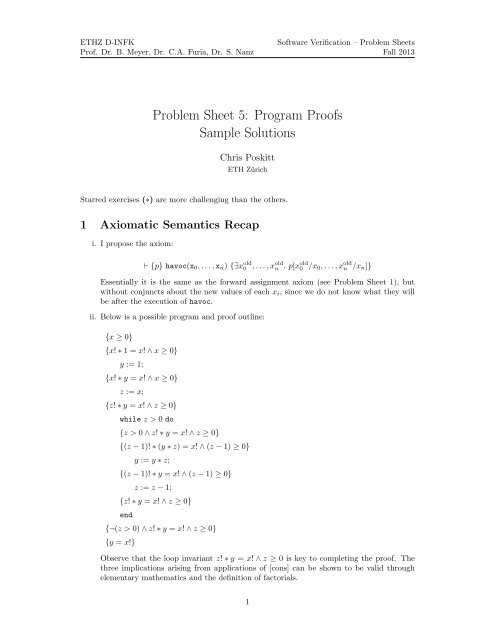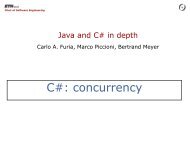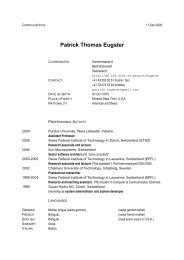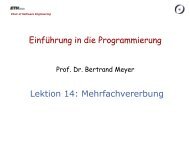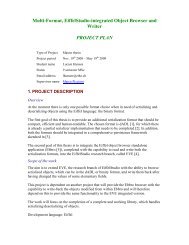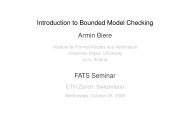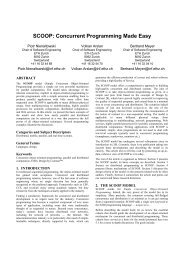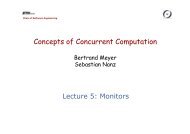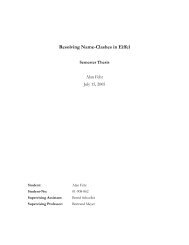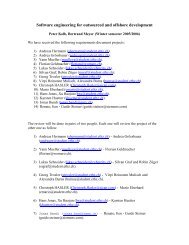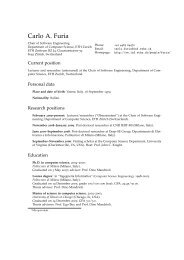Problem Sheet 5: Program Proofs Sample Solutions - ETH Zürich
Problem Sheet 5: Program Proofs Sample Solutions - ETH Zürich
Problem Sheet 5: Program Proofs Sample Solutions - ETH Zürich
You also want an ePaper? Increase the reach of your titles
YUMPU automatically turns print PDFs into web optimized ePapers that Google loves.
<strong>ETH</strong>Z D-INFK<br />
Prof. Dr. B. Meyer, Dr. C.A. Furia, Dr. S. Nanz<br />
Software Verification – <strong>Problem</strong> <strong>Sheet</strong>s<br />
Fall 2013<br />
<strong>Problem</strong> <strong>Sheet</strong> 5: <strong>Program</strong> <strong>Proofs</strong><br />
<strong>Sample</strong> <strong>Solutions</strong><br />
Chris Poskitt<br />
<strong>ETH</strong> Zürich<br />
Starred exercises (∗) are more challenging than the others.<br />
1 Axiomatic Semantics Recap<br />
i. I propose the axiom:<br />
⊢ {p} havoc(x 0 , . . . , x n ) {∃x old<br />
0 , . . . , x old<br />
n . p[x old<br />
0 /x 0 , . . . , x old<br />
n /x n ]}<br />
Essentially it is the same as the forward assignment axiom (see <strong>Problem</strong> <strong>Sheet</strong> 1), but<br />
without conjuncts about the new values of each x i , since we do not know what they will<br />
be after the execution of havoc.<br />
ii. Below is a possible program and proof outline:<br />
{x ≥ 0}<br />
{x! ∗ 1 = x! ∧ x ≥ 0}<br />
y := 1;<br />
{x! ∗ y = x! ∧ x ≥ 0}<br />
z := x;<br />
{z! ∗ y = x! ∧ z ≥ 0}<br />
while z > 0 do<br />
{z > 0 ∧ z! ∗ y = x! ∧ z ≥ 0}<br />
{(z − 1)! ∗ (y ∗ z) = x! ∧ (z − 1) ≥ 0}<br />
y := y ∗ z;<br />
{(z − 1)! ∗ y = x! ∧ (z − 1) ≥ 0}<br />
z := z − 1;<br />
{z! ∗ y = x! ∧ z ≥ 0}<br />
end<br />
{¬(z > 0) ∧ z! ∗ y = x! ∧ z ≥ 0}<br />
{y = x!}<br />
Observe that the loop invariant z! ∗ y = x! ∧ z ≥ 0 is key to completing the proof. The<br />
three implications arising from applications of [cons] can be shown to be valid through<br />
elementary mathematics and the definition of factorials.<br />
1
<strong>ETH</strong>Z D-INFK<br />
Prof. Dr. B. Meyer, Dr. C.A. Furia, Dr. S. Nanz<br />
Software Verification – <strong>Problem</strong> <strong>Sheet</strong>s<br />
Fall 2013<br />
iii. Assume that ⊢ {WP[P, post]} P {post} and |= {p} P {q}. From the definition of |=,<br />
executing P on a state satisfying p results in a state satisfying q. By definition, WP[P, post]<br />
expresses the weakest requirements on the state for P to establish q; hence p is either<br />
equivalent to or stronger than WP[P, post], and p ⇒ WP[P, post] is valid. Clearly, q ⇒ q<br />
is also valid, so we can apply the rule of consequence [cons] and derive the result that<br />
⊢ {p} P {q}.<br />
Note: this property is called relative completeness, i.e. all valid triples can be proven in the<br />
Hoare logic, relative to the existence of an oracle for deciding the validity of implications<br />
(such as those in [cons]).<br />
2 Separation Logic Recap<br />
i. There are instances of s, h and p such that the state satisfies the first assertion. For<br />
example,<br />
(x ↦→ 5), (5 ↦→ 5) |= x ↦→ x ∗ ¬x ↦→ x<br />
However, x = y ∗ ¬(x = y) is not satisfiable since x, y denote values in the store, which is<br />
heap-independent.<br />
ii.<br />
(a) Satisfies.<br />
(b) Does not satisfy (the heap only contains two locations).<br />
(c) Does not satisfy (the heap contains more than one location).<br />
(d) Satisfies. The variables x and y are indeed evaluated to the same location by the<br />
store. The second conjunct expresses that there is a location in the heap determined<br />
by evaluating y (clearly true).<br />
(e) Satisfies.<br />
iii. A proof outline is given below:<br />
{emp}<br />
x := cons(5, 9);<br />
{x ↦→ 5, 9}<br />
y := cons(6, 7);<br />
{x ↦→ 5, 9 ∗ y ↦→ 6, 7}<br />
{∃x old . x ↦→ 5, 9 ∗ y ↦→ 6, 7 ∧ x old = x}<br />
x := [x];<br />
{∃x old . x old ↦→ 5, 9 ∗ y ↦→ 6, 7 ∧ x = 5}<br />
[y + 1] := 9;<br />
{∃x old . x old ↦→ 5, 9 ∗ y ↦→ 6, 9 ∧ x = 5}<br />
dispose(y);<br />
{∃x old . x old ↦→ 5, 9 ∗ y + 1 ↦→ 9 ∧ x = 5}<br />
and a depiction of the final state:<br />
2
<strong>ETH</strong>Z D-INFK<br />
Prof. Dr. B. Meyer, Dr. C.A. Furia, Dr. S. Nanz<br />
Software Verification – <strong>Problem</strong> <strong>Sheet</strong>s<br />
Fall 2013<br />
Store<br />
Heap<br />
x<br />
y<br />
5 5 9<br />
9<br />
3 Graph-Based Reasoning and Verification<br />
i. If P is executed on a graph satisfying c, then any graph that results will satisfy d.<br />
This definition handles nondeterminism by requiring that all of the possible (proper) poststates<br />
satisfy the the postcondition. The definition does not guarantee the absence of<br />
program failures.<br />
ii. The program (destructively) tests whether or not the input graph was a tree. It iteratively<br />
attempts to delete all the leaves by exploiting the dangling condition (nodes can only be<br />
deleted if all the edges they are incident to are also deleted by the rule), until finally only<br />
the root of the tree is left, and then deleted by finalChop. If at this stage the graph is<br />
empty, then the original graph was a tree; otherwise it was not.<br />
A possible yes-run:<br />
=> =><br />
=> => =><br />
=><br />
“yes”<br />
. . . and a possible no-run:<br />
3
<strong>ETH</strong>Z D-INFK<br />
Prof. Dr. B. Meyer, Dr. C.A. Furia, Dr. S. Nanz<br />
Software Verification – <strong>Problem</strong> <strong>Sheet</strong>s<br />
Fall 2013<br />
=> =><br />
“no”<br />
Graph reduction can be used to specify a wide range of pointer structures, see e.g.<br />
http://www.cs.york.ac.uk/plasma/publications/pdf/BakewellPlumpRunciman.04b.<br />
pdf<br />
iii. The following program should respect the given specification:<br />
main = addLoop!<br />
addLoop(a : int)<br />
a*a<br />
a<br />
1<br />
where not edge(1,1)<br />
=><br />
a<br />
1<br />
iv. The following program deletes the entire graph yet respects the given specification:<br />
main = {deleteEdge,deleteLoop,deleteNode}!<br />
deleteEdge(k,x,y : list)<br />
deleteLoop(k,x : list)<br />
k<br />
k<br />
x y x<br />
=><br />
1 2<br />
1<br />
y<br />
2<br />
x<br />
1<br />
=><br />
x<br />
1<br />
deleteNode(x : list)<br />
x<br />
=> ;<br />
An obvious frame axiom would be: “the nodes, edges, and labels of the input graph are<br />
all preserved in the output graph”.<br />
v. A possible proof rule might be:<br />
[or]<br />
⊢ {c} P {d} ⊢ {c} Q {d}<br />
⊢ {c} P or Q {d}<br />
4
<strong>ETH</strong>Z D-INFK<br />
Prof. Dr. B. Meyer, Dr. C.A. Furia, Dr. S. Nanz<br />
Software Verification – <strong>Problem</strong> <strong>Sheet</strong>s<br />
Fall 2013<br />
vi. A possible proof rule might be:<br />
[if 2 ]<br />
⊢ {c ∧ App(R)} P {d} c ∧ ¬App(R) ⇒ d<br />
⊢ {c} if R then P {d}<br />
vii. This expresses that there exists a node incident to a loop, and moreover, there is not<br />
another node distinct from it that also is incident to a loop:<br />
y y b<br />
9( x , ¬9( x a ))<br />
1 1<br />
5


